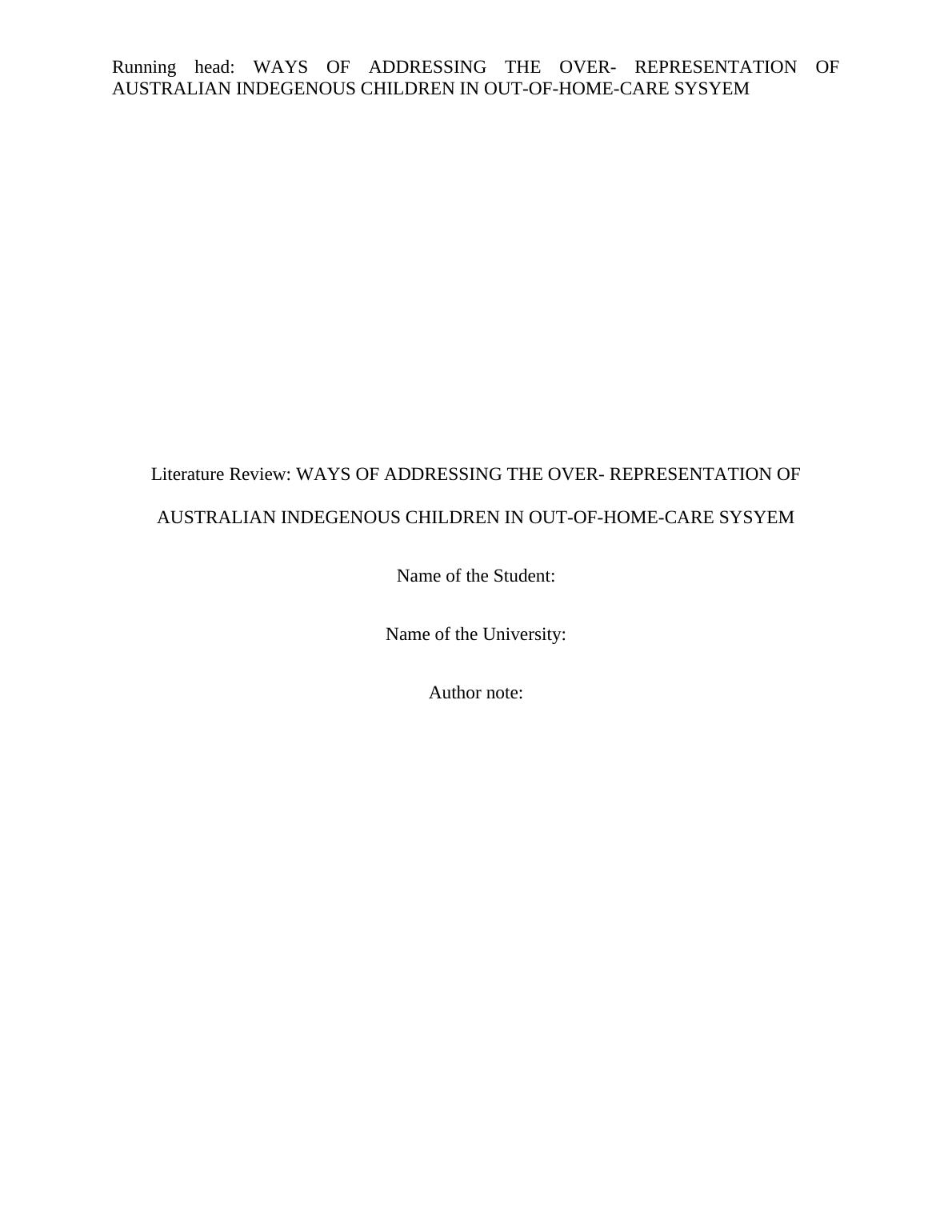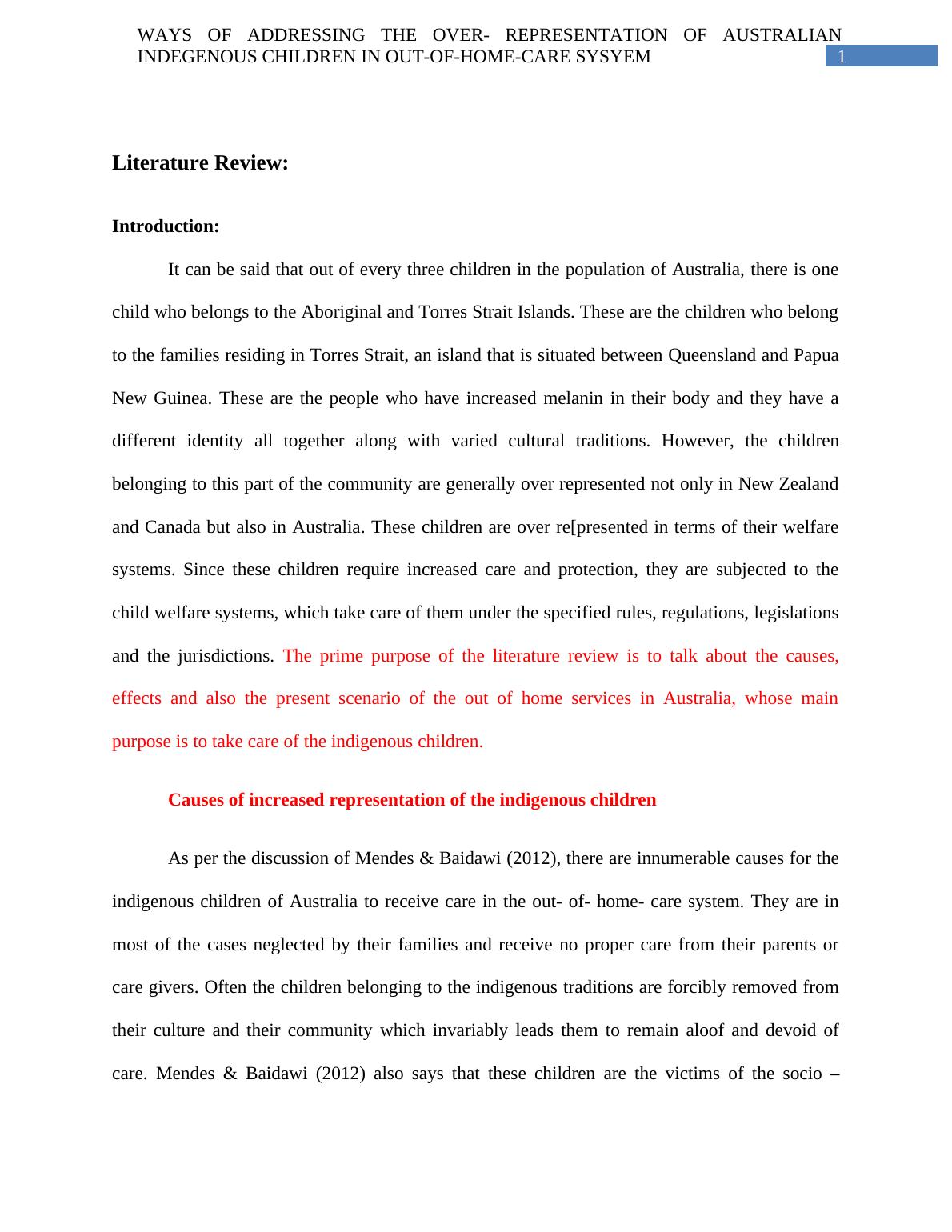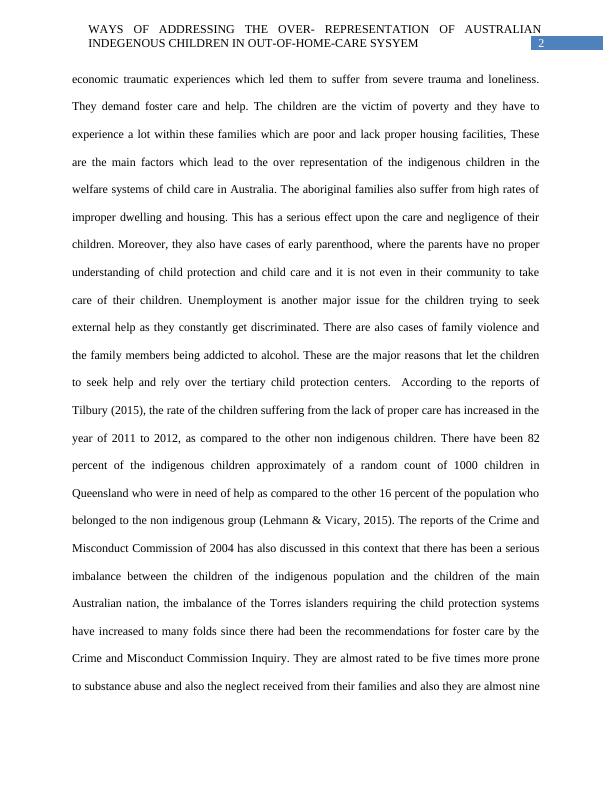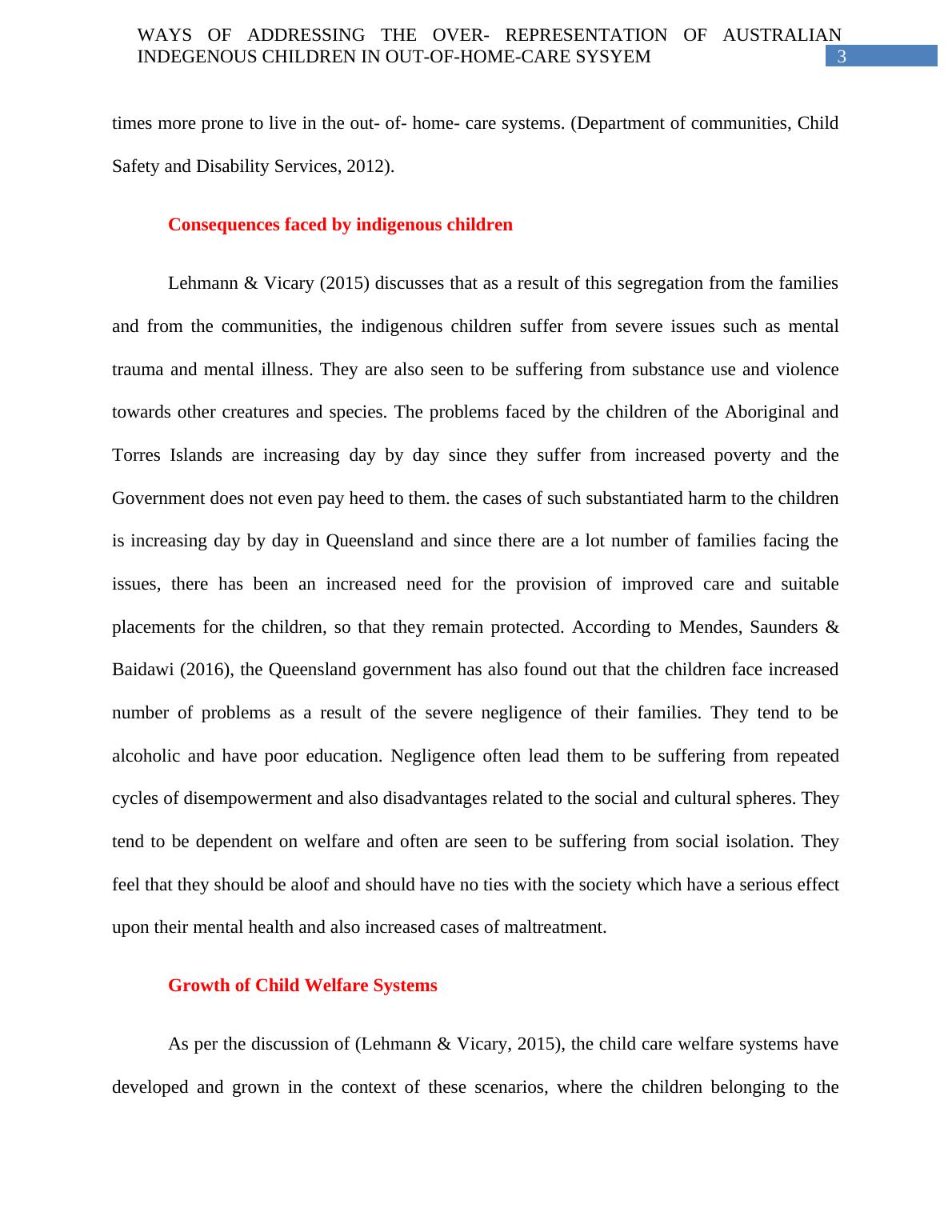Assignment about Ways of Addressing the Over
Added on 2022-09-23
11 Pages3377 Words21 Views
Running head: WAYS OF ADDRESSING THE OVER- REPRESENTATION OF
AUSTRALIAN INDEGENOUS CHILDREN IN OUT-OF-HOME-CARE SYSYEM
Literature Review: WAYS OF ADDRESSING THE OVER- REPRESENTATION OF
AUSTRALIAN INDEGENOUS CHILDREN IN OUT-OF-HOME-CARE SYSYEM
Name of the Student:
Name of the University:
Author note:
AUSTRALIAN INDEGENOUS CHILDREN IN OUT-OF-HOME-CARE SYSYEM
Literature Review: WAYS OF ADDRESSING THE OVER- REPRESENTATION OF
AUSTRALIAN INDEGENOUS CHILDREN IN OUT-OF-HOME-CARE SYSYEM
Name of the Student:
Name of the University:
Author note:

1
WAYS OF ADDRESSING THE OVER- REPRESENTATION OF AUSTRALIAN
INDEGENOUS CHILDREN IN OUT-OF-HOME-CARE SYSYEM
Literature Review:
Introduction:
It can be said that out of every three children in the population of Australia, there is one
child who belongs to the Aboriginal and Torres Strait Islands. These are the children who belong
to the families residing in Torres Strait, an island that is situated between Queensland and Papua
New Guinea. These are the people who have increased melanin in their body and they have a
different identity all together along with varied cultural traditions. However, the children
belonging to this part of the community are generally over represented not only in New Zealand
and Canada but also in Australia. These children are over re[presented in terms of their welfare
systems. Since these children require increased care and protection, they are subjected to the
child welfare systems, which take care of them under the specified rules, regulations, legislations
and the jurisdictions. The prime purpose of the literature review is to talk about the causes,
effects and also the present scenario of the out of home services in Australia, whose main
purpose is to take care of the indigenous children.
Causes of increased representation of the indigenous children
As per the discussion of Mendes & Baidawi (2012), there are innumerable causes for the
indigenous children of Australia to receive care in the out- of- home- care system. They are in
most of the cases neglected by their families and receive no proper care from their parents or
care givers. Often the children belonging to the indigenous traditions are forcibly removed from
their culture and their community which invariably leads them to remain aloof and devoid of
care. Mendes & Baidawi (2012) also says that these children are the victims of the socio –
WAYS OF ADDRESSING THE OVER- REPRESENTATION OF AUSTRALIAN
INDEGENOUS CHILDREN IN OUT-OF-HOME-CARE SYSYEM
Literature Review:
Introduction:
It can be said that out of every three children in the population of Australia, there is one
child who belongs to the Aboriginal and Torres Strait Islands. These are the children who belong
to the families residing in Torres Strait, an island that is situated between Queensland and Papua
New Guinea. These are the people who have increased melanin in their body and they have a
different identity all together along with varied cultural traditions. However, the children
belonging to this part of the community are generally over represented not only in New Zealand
and Canada but also in Australia. These children are over re[presented in terms of their welfare
systems. Since these children require increased care and protection, they are subjected to the
child welfare systems, which take care of them under the specified rules, regulations, legislations
and the jurisdictions. The prime purpose of the literature review is to talk about the causes,
effects and also the present scenario of the out of home services in Australia, whose main
purpose is to take care of the indigenous children.
Causes of increased representation of the indigenous children
As per the discussion of Mendes & Baidawi (2012), there are innumerable causes for the
indigenous children of Australia to receive care in the out- of- home- care system. They are in
most of the cases neglected by their families and receive no proper care from their parents or
care givers. Often the children belonging to the indigenous traditions are forcibly removed from
their culture and their community which invariably leads them to remain aloof and devoid of
care. Mendes & Baidawi (2012) also says that these children are the victims of the socio –

2
WAYS OF ADDRESSING THE OVER- REPRESENTATION OF AUSTRALIAN
INDEGENOUS CHILDREN IN OUT-OF-HOME-CARE SYSYEM
economic traumatic experiences which led them to suffer from severe trauma and loneliness.
They demand foster care and help. The children are the victim of poverty and they have to
experience a lot within these families which are poor and lack proper housing facilities, These
are the main factors which lead to the over representation of the indigenous children in the
welfare systems of child care in Australia. The aboriginal families also suffer from high rates of
improper dwelling and housing. This has a serious effect upon the care and negligence of their
children. Moreover, they also have cases of early parenthood, where the parents have no proper
understanding of child protection and child care and it is not even in their community to take
care of their children. Unemployment is another major issue for the children trying to seek
external help as they constantly get discriminated. There are also cases of family violence and
the family members being addicted to alcohol. These are the major reasons that let the children
to seek help and rely over the tertiary child protection centers. According to the reports of
Tilbury (2015), the rate of the children suffering from the lack of proper care has increased in the
year of 2011 to 2012, as compared to the other non indigenous children. There have been 82
percent of the indigenous children approximately of a random count of 1000 children in
Queensland who were in need of help as compared to the other 16 percent of the population who
belonged to the non indigenous group (Lehmann & Vicary, 2015). The reports of the Crime and
Misconduct Commission of 2004 has also discussed in this context that there has been a serious
imbalance between the children of the indigenous population and the children of the main
Australian nation, the imbalance of the Torres islanders requiring the child protection systems
have increased to many folds since there had been the recommendations for foster care by the
Crime and Misconduct Commission Inquiry. They are almost rated to be five times more prone
to substance abuse and also the neglect received from their families and also they are almost nine
WAYS OF ADDRESSING THE OVER- REPRESENTATION OF AUSTRALIAN
INDEGENOUS CHILDREN IN OUT-OF-HOME-CARE SYSYEM
economic traumatic experiences which led them to suffer from severe trauma and loneliness.
They demand foster care and help. The children are the victim of poverty and they have to
experience a lot within these families which are poor and lack proper housing facilities, These
are the main factors which lead to the over representation of the indigenous children in the
welfare systems of child care in Australia. The aboriginal families also suffer from high rates of
improper dwelling and housing. This has a serious effect upon the care and negligence of their
children. Moreover, they also have cases of early parenthood, where the parents have no proper
understanding of child protection and child care and it is not even in their community to take
care of their children. Unemployment is another major issue for the children trying to seek
external help as they constantly get discriminated. There are also cases of family violence and
the family members being addicted to alcohol. These are the major reasons that let the children
to seek help and rely over the tertiary child protection centers. According to the reports of
Tilbury (2015), the rate of the children suffering from the lack of proper care has increased in the
year of 2011 to 2012, as compared to the other non indigenous children. There have been 82
percent of the indigenous children approximately of a random count of 1000 children in
Queensland who were in need of help as compared to the other 16 percent of the population who
belonged to the non indigenous group (Lehmann & Vicary, 2015). The reports of the Crime and
Misconduct Commission of 2004 has also discussed in this context that there has been a serious
imbalance between the children of the indigenous population and the children of the main
Australian nation, the imbalance of the Torres islanders requiring the child protection systems
have increased to many folds since there had been the recommendations for foster care by the
Crime and Misconduct Commission Inquiry. They are almost rated to be five times more prone
to substance abuse and also the neglect received from their families and also they are almost nine

3
WAYS OF ADDRESSING THE OVER- REPRESENTATION OF AUSTRALIAN
INDEGENOUS CHILDREN IN OUT-OF-HOME-CARE SYSYEM
times more prone to live in the out- of- home- care systems. (Department of communities, Child
Safety and Disability Services, 2012).
Consequences faced by indigenous children
Lehmann & Vicary (2015) discusses that as a result of this segregation from the families
and from the communities, the indigenous children suffer from severe issues such as mental
trauma and mental illness. They are also seen to be suffering from substance use and violence
towards other creatures and species. The problems faced by the children of the Aboriginal and
Torres Islands are increasing day by day since they suffer from increased poverty and the
Government does not even pay heed to them. the cases of such substantiated harm to the children
is increasing day by day in Queensland and since there are a lot number of families facing the
issues, there has been an increased need for the provision of improved care and suitable
placements for the children, so that they remain protected. According to Mendes, Saunders &
Baidawi (2016), the Queensland government has also found out that the children face increased
number of problems as a result of the severe negligence of their families. They tend to be
alcoholic and have poor education. Negligence often lead them to be suffering from repeated
cycles of disempowerment and also disadvantages related to the social and cultural spheres. They
tend to be dependent on welfare and often are seen to be suffering from social isolation. They
feel that they should be aloof and should have no ties with the society which have a serious effect
upon their mental health and also increased cases of maltreatment.
Growth of Child Welfare Systems
As per the discussion of (Lehmann & Vicary, 2015), the child care welfare systems have
developed and grown in the context of these scenarios, where the children belonging to the
WAYS OF ADDRESSING THE OVER- REPRESENTATION OF AUSTRALIAN
INDEGENOUS CHILDREN IN OUT-OF-HOME-CARE SYSYEM
times more prone to live in the out- of- home- care systems. (Department of communities, Child
Safety and Disability Services, 2012).
Consequences faced by indigenous children
Lehmann & Vicary (2015) discusses that as a result of this segregation from the families
and from the communities, the indigenous children suffer from severe issues such as mental
trauma and mental illness. They are also seen to be suffering from substance use and violence
towards other creatures and species. The problems faced by the children of the Aboriginal and
Torres Islands are increasing day by day since they suffer from increased poverty and the
Government does not even pay heed to them. the cases of such substantiated harm to the children
is increasing day by day in Queensland and since there are a lot number of families facing the
issues, there has been an increased need for the provision of improved care and suitable
placements for the children, so that they remain protected. According to Mendes, Saunders &
Baidawi (2016), the Queensland government has also found out that the children face increased
number of problems as a result of the severe negligence of their families. They tend to be
alcoholic and have poor education. Negligence often lead them to be suffering from repeated
cycles of disempowerment and also disadvantages related to the social and cultural spheres. They
tend to be dependent on welfare and often are seen to be suffering from social isolation. They
feel that they should be aloof and should have no ties with the society which have a serious effect
upon their mental health and also increased cases of maltreatment.
Growth of Child Welfare Systems
As per the discussion of (Lehmann & Vicary, 2015), the child care welfare systems have
developed and grown in the context of these scenarios, where the children belonging to the

End of preview
Want to access all the pages? Upload your documents or become a member.
Related Documents
Developing Cultural Competence: Aboriginal and Torres Strait Islander Peoplelg...
|11
|3221
|71
Diabetes Incidence among the Australian Indigenous Populationlg...
|10
|2433
|182
Comparing Groups: Aboriginal and Torres Strait Islander People and LGBT Community in Australialg...
|10
|2837
|448
Comparing group assignment PDFlg...
|10
|2813
|110
Reproductive and Sexual Health: Issues Faced by Aboriginals and Torres Strait Islanders in Australialg...
|4
|698
|208
Stolen Generationlg...
|1
|633
|78
